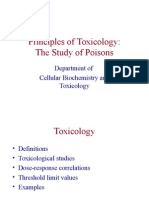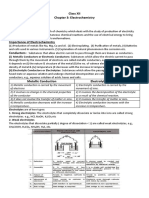Electrolytic Conductors or Electrolytes
Uploaded by
Krushang PatelElectrolytic Conductors or Electrolytes
Uploaded by
Krushang PatelElectrochemistry is that branch of chemistry which deals with the study of production of electricity
from energy released during spontaneous chemical reactions and the use of electrical energy to
bring about non-spontaneous chemical transformations.
Importance of Electrochemistry
Production of metals like Na, Mg. Ca and Al.
Electroplating.
Purification of metals.
Batteries and cells used in various instruments.
Conductors
Substances that allow electric current to pass through them are known as conductors.
Metallic Conductors or Electronic Conductors
Substances which allow the electric current to pass through them by the movement of
electrons are called metallic conductors, e.g.. metals.
Electrolytic Conductors or Electrolytes
Substances which allow the passage of electricity through their fused state or aqueous
solution and undergo chemical decomposition are called electrolytic conductors, e.g.,
aqueous solution of acids. bases and salts.
Electrolytes are of two types:
1. Strong electrolytes The electrolytes that completely dissociate or ionise into ions are called
strong electrolytes. e.g., HCl, NaOH, K2SO4
2. Weak electrolytes The electrolytes that dissociate partially (ex < 1) are called weak
electrolytes, e.g., CH3COOH, H2CO3, NH4OHH2S, etc.
Electrochemical Cell and Electrolytic
A cell of almost constant emf is called standard cell. The most common is Weston standard
cell.
Galvanic cell is also called voltaic cell.
General Representation of an Electrochemical Cell
Other features of the electrochemical cell are
1. There is no evolution of heat.
2. The solution remains neutral on both sides.
3. Transport number of cation. na = (current carried by anion/total current)
4. Evidently nc + na = 1
5. Electrode Potential
6. When an electrode is in contact with the solution of its ions in a half-cell, it has a
tendency to lose or gain electrons which is known as electrode potential. It is
expressed in volts. It is an intensive property, i.e., independent of the amount of
species in the reaction.
7. Oxidation potential The tendency to lose electrons in the above case is known as
oxidation potential. Oxidation potential of a half-cell is inversely proportional to the
concentration of ions in the solution.
8.
9. The reaction and now of electrons stops after sometime.
Daniell Cell
An electrochemical cell of zinc and copper metals is known as Daniell cell. It is represented
as
By convention cathode is represented on the RHS and anode on the LHS.
Function of salt bridge
1. It completes the circuit and allows the flow of current.
2. It maintains the electrical neutrality on both sides. Salt-bridge generally contains solution of
strong electrolyte such as KNO3, KCL etc. KCI is preferred because the transport numbers of
K+ and Cl– are almost same.
Transport number or Transference number The current flowing through an electrolytic
solution is carried by the ions. The fraction of the current carried by an ion is called its
transport number or transference number. Thus.
Transport number of cation. nc = (current carried by cation/t
Transport number of cation. na = (current carried by anion/total current)
Evidently nc + na = 1
Electrode Potential
When an electrode is in contact with the solution of its ions in a half-cell, it has a tendency to
lose or gain electrons which is known as electrode potential. It is expressed in volts. It is an
intensive property, i.e., independent of the amount of species in the reaction.
Oxidation potential The tendency to lose electrons in the above case is known as oxidation
potential. Oxidation potential of a half-cell is inversely proportional to the concentration of
ions in the solution.
Transport number of cation. na = (current carried by anion/total current)
Evidently nc + na = 1
Electrode Potential
When an electrode is in contact with the solution of its ions in a half-cell, it has a tendency to
lose or gain electrons which is known as electrode potential. It is expressed in volts. It is an
intensive property, i.e., independent of the amount of species in the reaction.
Oxidation potential The tendency to lose electrons in the above case is known as oxidation
potential. Oxidation potential of a half-cell is inversely proportional to the concentration of
ions in the solution.
You might also like
- Medicinal and Environmental Chemistry: Experimental Advances and Simulations (Part I)From EverandMedicinal and Environmental Chemistry: Experimental Advances and Simulations (Part I)No ratings yet
- Electrochemistry: by Aryan Gupta Class 12 A (Non-Medical) Roll No.26604942No ratings yetElectrochemistry: by Aryan Gupta Class 12 A (Non-Medical) Roll No.2660494247 pages
- Homework How To Write A Paragraph? Google's SummaryNo ratings yetHomework How To Write A Paragraph? Google's Summary1 page
- Why Are Chemicals Not Named John? Naming Chemical Compounds 6th Grade | Children's Chemistry BooksFrom EverandWhy Are Chemicals Not Named John? Naming Chemical Compounds 6th Grade | Children's Chemistry BooksNo ratings yet
- Karunya University: School OF BiotechnologyNo ratings yetKarunya University: School OF Biotechnology335 pages
- Principles of Toxicology: The Study of PoisonsNo ratings yetPrinciples of Toxicology: The Study of Poisons42 pages
- Chapter 02 - Structure and Synthesis of PFDNo ratings yetChapter 02 - Structure and Synthesis of PFD72 pages
- Heterogeneous Fenton Catalyst Supports Screening For Mono Azo Dye Degradation in Contaminated WastewatersNo ratings yetHeterogeneous Fenton Catalyst Supports Screening For Mono Azo Dye Degradation in Contaminated Wastewaters8 pages
- Table 1.1 Separation Methods: Chapter 1-IntroductionNo ratings yetTable 1.1 Separation Methods: Chapter 1-Introduction31 pages
- Exam Prep for:: Physical Chemistry and Acid-base Properties of SurfaceFrom EverandExam Prep for:: Physical Chemistry and Acid-base Properties of SurfaceNo ratings yet
- US Army Medical Course MD0549-200 - Psycho Social Issues100% (2)US Army Medical Course MD0549-200 - Psycho Social Issues86 pages
- EVALUATION AND ASSESSMENT FRAMEWORKS - Summary PDFNo ratings yetEVALUATION AND ASSESSMENT FRAMEWORKS - Summary PDF10 pages
- Theory On Coagulation, Flocculation and Precipitation, Chemistry For Wastewater TreatmentNo ratings yetTheory On Coagulation, Flocculation and Precipitation, Chemistry For Wastewater Treatment14 pages
- CYC 517 Physical Chemistry Lab II MSC 3rd SEMNo ratings yetCYC 517 Physical Chemistry Lab II MSC 3rd SEM36 pages
- Ozone Science & Engineering - Thirty Three Years and GrowingNo ratings yetOzone Science & Engineering - Thirty Three Years and Growing22 pages
- Conductivity Theory and Practice - Radiometer Analytical SAS100% (5)Conductivity Theory and Practice - Radiometer Analytical SAS50 pages
- Rotating Disk Electrode: - A Hydrodynamic MethodNo ratings yetRotating Disk Electrode: - A Hydrodynamic Method15 pages
- Title: Simple Pendulum: Name: Shreya KanwarNo ratings yetTitle: Simple Pendulum: Name: Shreya Kanwar19 pages
- Sedimentation: Downstream Processing Short Course May 2007 Kevin Street Gavin DuffyNo ratings yetSedimentation: Downstream Processing Short Course May 2007 Kevin Street Gavin Duffy16 pages
- Creole Composition: Academic Writing and Rhetoric in the Anglophone CaribbeanFrom EverandCreole Composition: Academic Writing and Rhetoric in the Anglophone CaribbeanNo ratings yet
- Download full An Introduction to Proof through Real Analysis 1st Edition Daniel J. Madden ebook all chapters100% (3)Download full An Introduction to Proof through Real Analysis 1st Edition Daniel J. Madden ebook all chapters51 pages
- Parts of A Microwave Oven Magnetron TubeNo ratings yetParts of A Microwave Oven Magnetron Tube4 pages
- Functional Safety Machinery Directive PDFNo ratings yetFunctional Safety Machinery Directive PDF135 pages
- Sustainable Belt Conveyor Operation by Active Speed ControlNo ratings yetSustainable Belt Conveyor Operation by Active Speed Control9 pages
- [Process Safety Progress Vol. 17 Iss. 4] M. Walter_ R. Lesicki - Measures Taken to Ensure Safe Operation of an Ammonia Storage Tank (1998) [10.1002_prs.680170410] - Libgen.liNo ratings yet[Process Safety Progress Vol. 17 Iss. 4] M. Walter_ R. Lesicki - Measures Taken to Ensure Safe Operation of an Ammonia Storage Tank (1998) [10.1002_prs.680170410] - Libgen.li9 pages
- Philippine Agricultural Engineering StandardNo ratings yetPhilippine Agricultural Engineering Standard10 pages
- 1.7.1 Prismatic Properties: Figure 1-34: Prismatic Property Nomenclature For A T and Trapezoidal SectionNo ratings yet1.7.1 Prismatic Properties: Figure 1-34: Prismatic Property Nomenclature For A T and Trapezoidal Section2 pages
- ECG353-chapter 2 - Vertical Stress Distribution - Part 2No ratings yetECG353-chapter 2 - Vertical Stress Distribution - Part 221 pages
- Welder Performance Qualification (WPQ) According To ASME IX Hassan HussienNo ratings yetWelder Performance Qualification (WPQ) According To ASME IX Hassan Hussien1 page

























































































